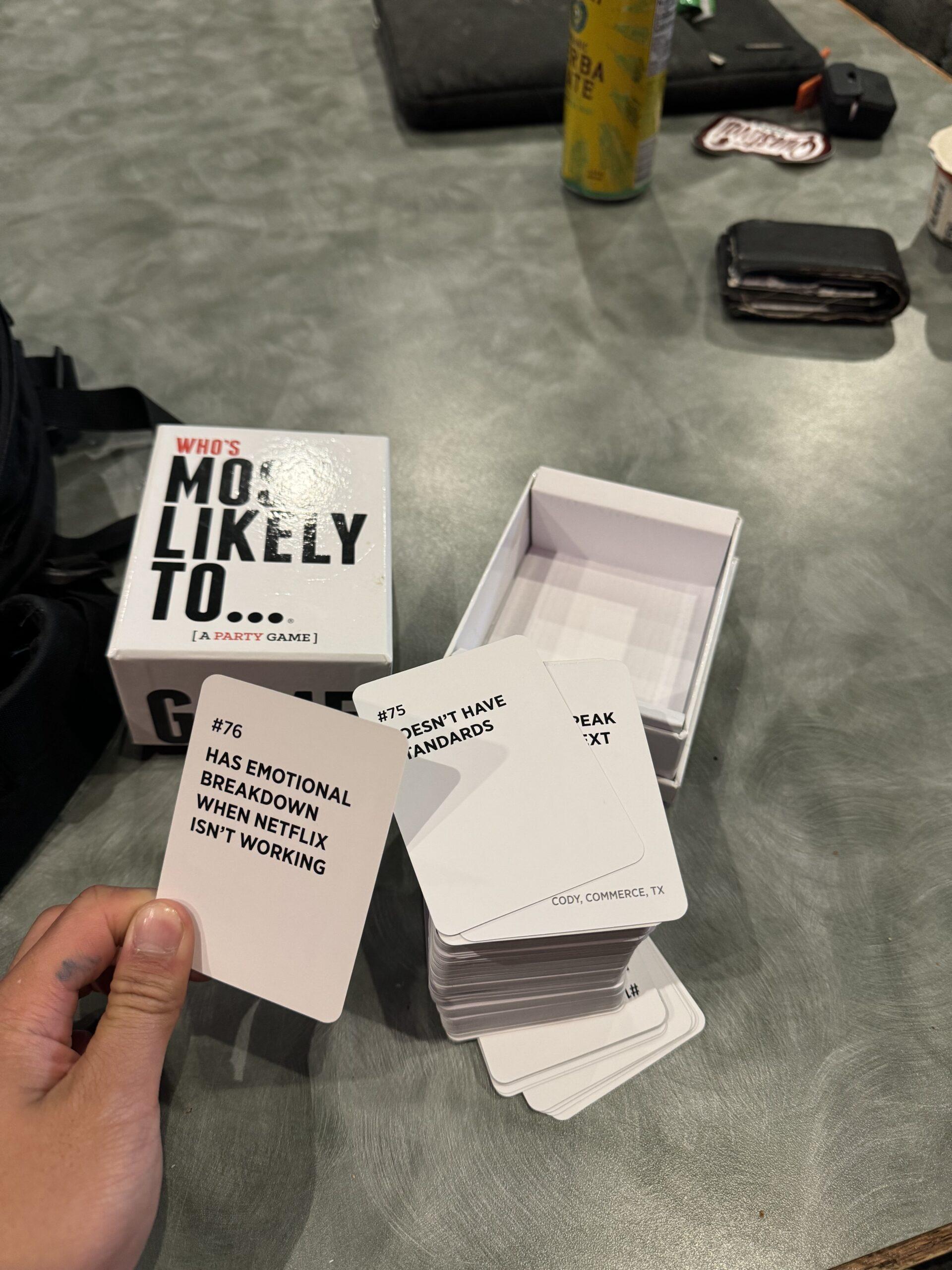Most Likely To – Critical Play: Competitive Analysis
Introduction
“Most Likely To” is a popular party game where players, through a series of provocative and often humorous cards, decide which group member is most likely to engage in certain behaviors. The game is famed for its straightforward yet revealing gameplay, designed to provoke laughter and occasional discomfort among friends.
Our game concept, while sharing the party game genre, introduces a blend of mechanics from Egyptian Rat Slap and BS, adding a layer of physicality and deceit that transforms the social dynamics from purely discussion based into a strategic game of truth and bluff.
Central Argument
While “Most Likely To” focuses on group consensus and social perceptions, our game enhances player interaction by incorporating physical and strategic elements. This not only diversifies the gameplay but also amplifies the stakes involved, making each player’s turn a critical moment of gameplay. Unlike the static nature of “Most Likely To,” where players simply debate and decide, our game demands quick reflexes, sharp observation, and the ability to deceive smoothly, integrating more dynamic interactions.
Analysis
“Most Likely To” operates on the principle of social judgment, where players use known or presumed personality traits to assign others with potentially embarrassing labels. This straightforward mechanism fosters engagement through conversation and debate, appealing mainly to young adults and older teenagers looking for casual, fun interactions at social gatherings.
In contrast, our game builds on this foundation with innovative mechanics that introduce physicality and strategy. Inspired by the fast-paced action of Egyptian Rat Slap, our game adds an urgent kinetic energy into the gameplay. The tactile element of slapping cards not only quickens the pace but also heightens the physical engagement of players.
Moreover, by incorporating bluffing elements from BS, “Truth or Dare Slap” complicates the decision-making process, as players must discern whether responses are truthful or deceptive. This integration significantly differentiates our game from “Most Likely To” by merging physical reflexes with psychological tactics, thus appealing to a broader audience that enjoys both strategy and social interaction.
The addition of embarrassing questions as penalties for the last person to slap the pile deepens the personal stakes of the game, making each round about more than just quick hands but also about quick thinking. Players must balance the risk of fast reactions with the potential embarrassment of answering a revealing question under the pressure of a bluff or truth card. This feature introduces a unique layer of social dynamics not present in “Most Likely To,” offering players a challenging yet humorous experience that tests both their mental and physical agility.
Suggestions for improvement could include varying the difficulty of the questions based on the game’s progression to maintain player engagement and escalating stakes. Insightful critiques could highlight the game’s ability to blend physical activity with social interaction.
By comparing “Most likely to” to other games in its genre, it’s probably the simplest game of them all. The whole idea is based on discussing which person fits a certain label. There’s not really an objective with much stakes. As a game, people aren’t really playing to win, but rather to get to know the other people. But it does result in a lot of lively engaging conversations.
Evidence
During our play sessions of “Most Likely To,” the most engaging and memorable moments arose when we found really embarrassing labels. Some examples are: “most likely to drunk dial their ex”, “most likely to marry someone they just met in Vegas”, and “most likely to join a cult by accident”. These instances sparked lively debates filled with humor and strategic arguments, as players passionately discussed why someone deserved the embarrassing tag. Inspired by this level of engagement, we plan to incorporate similarly embarrassing questions into our game. By doing so, we aim to maintain high stakes and ensure that players are fully invested in the gameplay which mirrors the intense involvement and entertainment we observed.
Conclusion
While “Most Likely To” remains a beloved game for its simplicity and direct approach to unveiling personalities, our game introduces additional layers of gameplay that enhance interaction and challenge. By merging physical reflexes with strategic deceit and personal revelations, our game not only entertains but also offers a deeper, more complex exploration of friendships and social boundaries.




